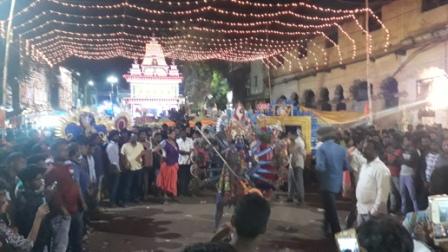Jeypore: Jeypore Dusherra, one of the oldest traditional Dussehra festivals in the country, has come to an end.
The Jeypore Dussehra celebrations are compared to the Mysore Dussehra as it is a mix of royal and tribal traditions. It is celebrated in the tribal regions of Koraput despite the onslaught of modern lifestyles and values.
There may not be horses or elephants at the Dussehra procession now, but the beating of huge drums, the presence of the former king and the festival fervour reminds one of the glorious past of the erstwhile Jeypore kingdom.
The tribal rituals and the tradition of carrying bamboo lathis which represent deities coming from far off places to Jeypore makes the Jeypore Dussehra colourful.
The 16-day Dusherra festival starts with the worshipping of Goddess Maa Bhagbati by the Chairman of the Dusherra Puja Committee, Tara Bahinipati, who is also the MLA of Jeypore. There is still a practice of sending invitations to all major deities of the region immediately after the Maa Bhagbati Puja.
The traditional Dussehra starts with the visit of tribals from different places with their drums, swords among others which are kept on village altars after worshipping them.
On the auspicious day they wear new dresses and tribal Pujaris, Nayak, Bariks, Gondas and village headsmen conduct the rituals. They also seek donations of sarees, money and rice from villages.
On the first day of Dussehra the tribal headsman observes special rituals. After the pujas the bamboo sticks or lathis kept for puja purposes in the villages are taken by the villagers to the Jeypore Palace for the famous ‘Aparajita Puja.’
This year 91 lathis came from places like Narayanpatna, Nandapur, Umorkote, Raighar and many other places which accepted the request.
Legend says that the taking of the holy bamboo sticks to the palace symbolises the loyalty of tribal villages towards their rulers.
There is a belief that the Dussehra congregation is significant as they meet both the Goddess and rulers at the same place and time.
The main attraction of the puja is the continuous beating of drums and dancing of dhemsa by the tribal communities from Durua and Parja.
The last day of Dussehra is celebrated with lots of traditional dances and music.
Around 50,000 people gather to worship the Goddess, and a large procession is organised to the Dusherra Stadium for the Aparajita Puja after worshipping Lords Maa Dakhin Kali, Maa Bhagwati, Maa Kanak Durga and Maa Basantai.
The traditional music, tribal dances and music make the festival colourful, and it reflects the Dusherra celebrated in ancient times.
PNN






































